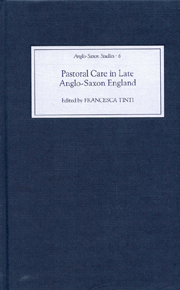Book contents
- Frontmatter
- Contents
- List of illustrations
- List of contributors
- Abbreviations
- Introduction
- 1 The clergy in English dioceses c. 900–c. 1066
- 2 The ‘costs’ of pastoral care: church dues in late Anglo-Saxon England
- 3 Ælfric in Dorset and the landscape of pastoral care
- 4 Is there any evidence for the liturgy of parish churches in late Anglo-Saxon England? The Red Book of Darley and the status of Old English
- 5 Remedies for ‘great transgressions’: penance and excommunication in late Anglo-Saxon England
- 6 The pastoral contract in late Anglo-Saxon England: priest and parishioner in Oxford, Bodleian Library, MS Laud Miscellaneous 482
- 7 Caring for the dead in late Anglo-Saxon England
- Index
7 - Caring for the dead in late Anglo-Saxon England
Published online by Cambridge University Press: 12 September 2012
- Frontmatter
- Contents
- List of illustrations
- List of contributors
- Abbreviations
- Introduction
- 1 The clergy in English dioceses c. 900–c. 1066
- 2 The ‘costs’ of pastoral care: church dues in late Anglo-Saxon England
- 3 Ælfric in Dorset and the landscape of pastoral care
- 4 Is there any evidence for the liturgy of parish churches in late Anglo-Saxon England? The Red Book of Darley and the status of Old English
- 5 Remedies for ‘great transgressions’: penance and excommunication in late Anglo-Saxon England
- 6 The pastoral contract in late Anglo-Saxon England: priest and parishioner in Oxford, Bodleian Library, MS Laud Miscellaneous 482
- 7 Caring for the dead in late Anglo-Saxon England
- Index
Summary
Textual evidence concerning the treatment of the dead in later Anglo-Saxon England provides an incomplete picture, and this article examines the ways in which the study of the archaeology of funerary practicesmay cast newlight on the issue. The burial practices of the earlier Anglo-Saxon period have been extensively studied, but those of the tenth and eleventh centuries have received comparatively little attention from archaeologists. While the results from a small number of well-excavated late Anglo-Saxon cemeteries have been published, either as full excavation reports or in summary form, the results of many other excavations remain unpublished and largely unknown. However, recent research has identified large numbers of tenth- and eleventh-century cemeteries across England, and has begun to explore the potential of this evidence. This article will highlight the diversity of both burial rite and burial location in the later Anglo-Saxon period and will examine the ways in which the archaeological evidence serves to complement the contemporary written evidence for the treatment of the dead. As we shall see, although burial was not as elaborate as it had been in earlier centuries, the funerary ritual was still used to convey important messages about the status of the dead and perhaps also about the likely fate of their souls in the afterlife. The variability of such signalling both in the grave and through the location of the burial suggests that they depended upon locally divergent initiatives and beliefs within individual communities, and that this continued even as the Church attempted to gain firmer control over burial during the tenth and eleventh centuries.
- Type
- Chapter
- Information
- Pastoral Care in Late Anglo-Saxon England , pp. 121 - 147Publisher: Boydell & BrewerPrint publication year: 2005



